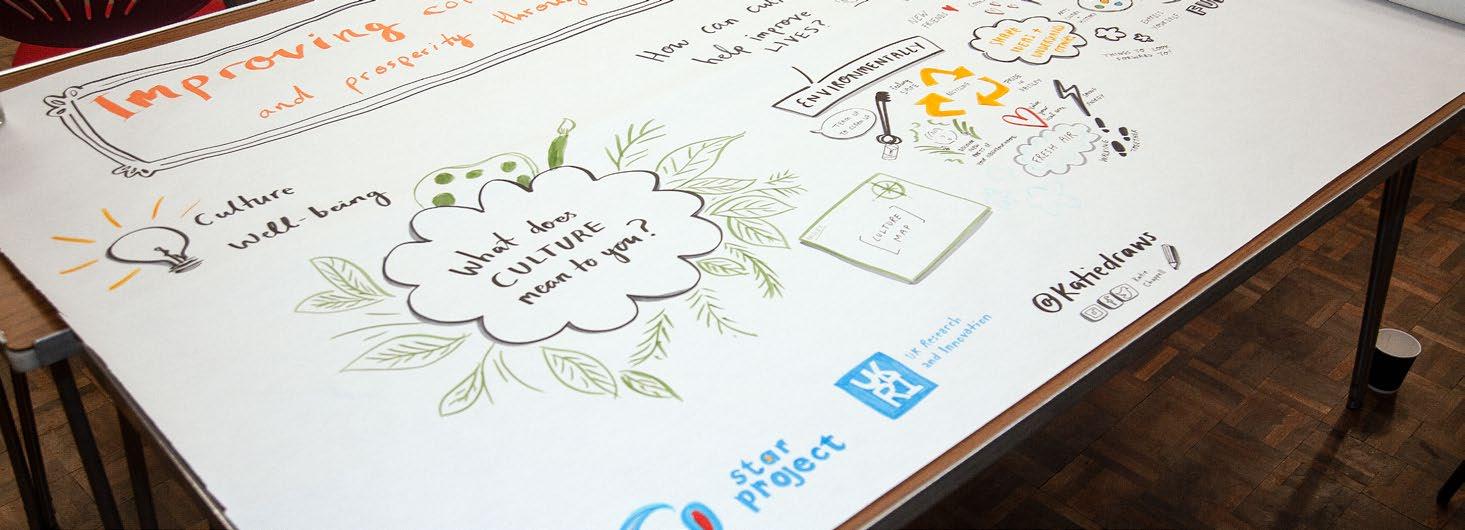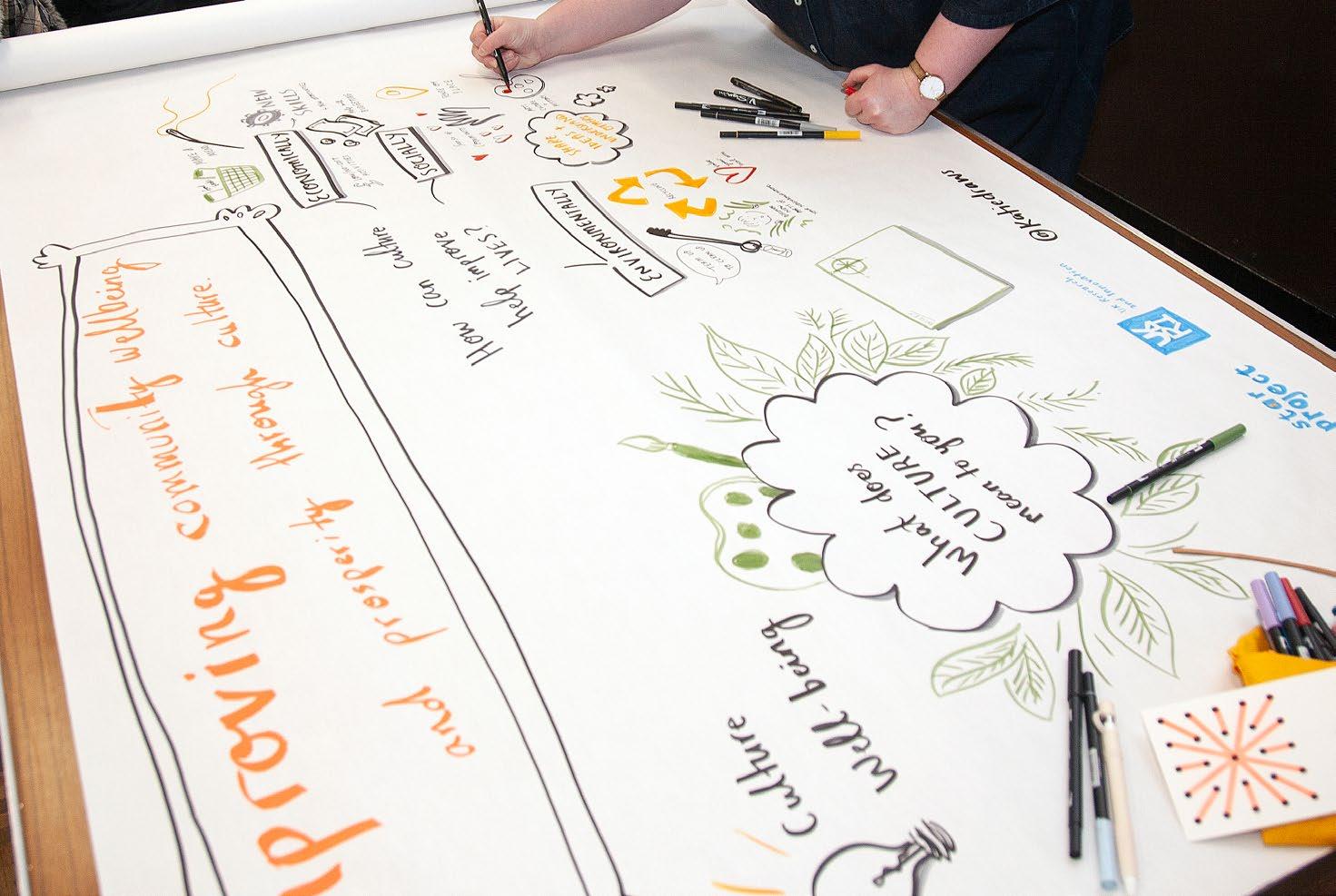
4 minute read
4.1 UK–based examples of interventions with more tangible economic effects
from The Role of Arts & Culture in Lifting Communities Out of Poverty, A Review of Evidence
by ccse_uws
reference, where the term is understood as ‘the process of putting culture in the service of the community, especially in the advancement of certain community defined goals’ (Dirksen, 2013:52). While Dirksen is clear that such undertakings will neither reorder society nor eliminate deep-rooted structural inequality, they do nevertheless ‘enable positive discourse and provide clear direction, as well as musical enjoyment’ (Dirksen, 2013: 54).
In his brief summary of the ways in which he and his theatre troupe utilise drama for poverty reduction, Daogo Guingané emphasises the awareness raising potential of drama interventions. Useful drama – socalled because it raises people’s awareness of issues relevant to them – is a popular intervention across the African continent, creating ‘a bridge between art and developmental issues’ which, Daogo Guingané argues has the effect of ‘encouraging people to change their behaviour, and helping to deal with moral and material poverty at its root’ (Daogo Guingané, 2010:10&12).
Advertisement
While neither Dirksen nor Daogo Guingané, propose that the cultural interventions they describe can ‘solve’ material poverty they do suggest that ‘if poverty is an absence of means, then culture can sometimes open the doors of possibility’ (Dirksen, 2013: 54). The approaches they reference are impactful but low cost (Dirksen, 2013: 54) and the outcomes described – i.e. increased agency, awareness – foreground some of less tangible, more psychosocial potential effects of interventions might accrue for people living in materially poor circumstances.




The above (section 4.0) shows that even in transition contexts, there are very few concrete examples in which arts and cultural interventions are directly leveraged to relieve material poverty. Rather, these are realms in which people may be able to take steps along a path which ultimately leads to greater material security. There are very few examples of UK based projects which tackle material poverty directly discussed in the literature and sources uncovered for this review. Testimony from Bevan Foundation Think Tank for the CWLC provides clues as to why this may be the case:
‘There is limited research that suggests that improving participation is the arts can be part of the solution to poverty, although on its own it has little effect. Involving people who live in poverty in the production of cultural events can lead to increased confidence and the development of new skills. This can provide an important step in encouraging those who are currently not in work to seek employment opportunities and it can also give confidence to those who are already employed to seek progression opportunities, boosting their incomes’ (CWLC, 2019:26).
There are – in truth – far fewer opportunities for the materially poor to become involved in the production of culture15 which might provide a more direct route out of poverty. Recently, there is noticeably increased focus on demography and experiences among those employed in cultural and creative industries sector (i.e. Creative Diversity All- Party Parliamentary Group, the Inquiry into Diversity in the Performing Arts (Labour Party, 2017)). Industry bodies representing employees have also examined trends in this arena (for example in the area of music work by Payne & Taylor, 2017; and Help Musicians, 2014). Scholarly investigation has also begun linking analyses of production and consumption (Oakley & O’Brien, 2015 & 2016; Brook, O’Brien & Taylor, 2020).
Interventions delivered as part of cultural regeneration work have not been foremost in the sources returned in searches conducted for this review. Campbell et al’s work critically reviewing the role of arts and culture in the regeneration of urban communities and places shows that the evidence of a positive correlation is weak (Campbell et al, 2015: 41-56). These authors provide ample examples of work that calls into question the ‘continued assertions that culture is playing a regenerative role, regardless of evidence, or in opposition to evidence, in the current decade’ (Campbell et al, 2015:45). While the purported economic impact of interventions can often be overstated (p. 41-42), the success of built regeneration and cultural programmes has led to a blurring of outcomes and an absence of clarity regarding the mechanisms through which they have been achieved (p.41-42). Part of this difficulty relates ‘not so much to the nature of the evidence gathered as what this evidence shows us, or what it is evidence for’ (p.43, emphasis in original) nevertheless, the challenge of demonstrating causality – particularly regarding the social impacts of regeneration work – remains (p. 43-44). For example, it has been recognised that there was no cost benefit analysis conducted for the Yorkshire Sculpture Park and ‘no consideration [of] whether this intervention was better than others, nor how much of the activity it stimulated would have occurred anyway, or had been displaced from other locations’ (Campbell et al, 2015:43).16
15 Giving evidence to the same committee, Morag McDermont (Professor of Socio-Legal Studies, University of Bristol) emphasised the need to locate cultural infrastructure in less well-off communities (CWLC, 2019:28). 16 Also see Section 3.0 re: Hepworth, Wakefield and the macro economic impacts of the museum.







